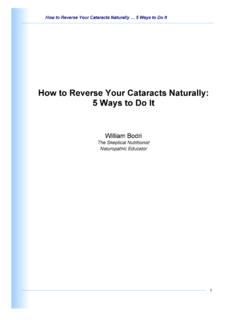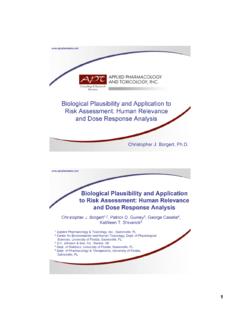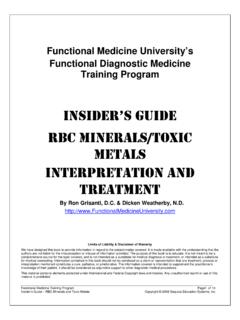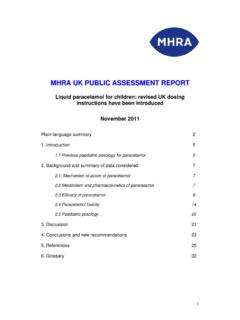Transcription of REVIEW OF N-ACETYLCYSTEINE FOR THE …
1 Second Meeting of the Subcommittee of the Expert Committee on the Selection and Use of Essential Medicines Geneva, 29 September to 3 October 2008. REVIEW OF N-ACETYLCYSTEINE FOR THE TREATMENT OF. ACETAMINOPHEN (PARACETAMOL) TOXICITY IN PEDIATRICS. D. Adam Algren, Assistant Professor of Emergency Medicine and Pediatrics Divisions of Emergency Medicine and Pediatric Pharmacology & Medical Toxicology University of Missouri Kansas City Attending Physician, Truman Medical Center, Kansas City, MO. Attending Medical Toxicologist, Children's Mercy Hospitals and Clinics, Kansas City, MO. 1. EXECUTIVE SUMMARY. Acetaminophen (paracetamol) toxicity is a common cause of drug-induced hepatotoxicity in children and adults. N-ACETYLCYSTEINE (NAC) has been used for several decades and has proven to be the antidote of choice in treating acetaminophen-induced hepatotoxicity. There is significant clinical evidence to support that oral and intravenous NAC are equally efficacious in the prevention of hepatotoxicity.
2 An important factor in assessing the efficacy of NAC is the timing of therapy initiation in relation to the ingestion. Patients that ingest an acute overdose and have NAC therapy initiated within 8 hours do well and have less than a 10% incidence of hepatotoxicity and generally do not develop liver failure or die. Those patients that chronically ingest excessive doses of acetaminophen over many hours and/or have NAC therapy initiated more than 8 hours after an acute overdose have an approximately 8-50% incidence of hepatotoxicity. Unlike clinical scenarios in which NAC therapy is initiated early, patients that have administration delayed are at risk of developing fulminant hepatic failure and death. Oral administration is the preferred route for NAC therapy unless contraindications exist ( aspiration, persistent vomiting). The usual recommended loading dose is 140. mg/kg followed in 4 hours by a maintenance dose of 70 mg/kg orally given every 4 hours.
3 This dosing is commonly recommended to be continued for 72 hours; however more recent clinical experience supports tailoring the duration of therapy to the patient's clinical condition. Intravenous NAC is recommended in situations in which the patient is not able to tolerate oral administration of NAC or has fulminant hepatic failure. The most commonly used IV protocol is to administer 150 mg/kg IV over 1 hour, followed by 50 mg/kg over 4. hours, then 100 mg/kg over 16 hours. A modified intravenous dosing formulation for pediatric patients (weighing less than 40 kg) is recommended to prevent excessive fluid administration. The antidotal efficacy of NAC is determined by great extent to the time that treatment is initiated after an overdose of acetaminophen. NAC therapy should be initiated within 8. hours of an acute ingestion and otherwise as soon as possible. While many protocols have defined lengths of treatment, it is generally recommended that NAC be administered until the serum acetaminophen concentration is undetectable (<10 mcg/ml) and the patient is clinically well with normal liver function tests.
4 In cases of hepatotoxicity, NAC should be continued until: 1) the serum liver transaminases fall to less than 1000 IU/L, bilirubin and coagulation studies are normal, and the patient is clinically well; 2) the patient receives a liver transplant;. or 3) the patient dies. Both oral and intravenous NAC are well tolerated. Nausea and vomiting are common with oral administration. Intravenous use has been associated with the development of anaphylactoid reactions. Generally these reactions are characterized by the development of a mild rash or urticaria. They typically respond to antihistamines and often the infusion is able to be completed. Life-threatening anaphylactoid reactions and deaths have been reported, but are uncommon. 2. PROPOSAL. The world health organization Model List of Essential Medicines and Model Formulary of 2006 lists acetylcysteine (NAC) as an antidote for use in the treatment of acetaminophen (paracetamol) ,2 It is proposed that acetylcysteine be considered the antidote of choice in the treatment of acetaminophen toxicity.
5 acetylcysteine is widely available and can be administered by both oral and intravenous (IV) routes. Both oral and IV. use of NAC in this setting have proven to be safe and effective. INTRODUCTION. Acetaminophen (Paracetamol) is used worldwide for its analgesic and antipyretic properties. It is widely available and present in many prescription and non-prescription medications. Unfortunately, however, acetaminophen toxicity remains the most common cause of drug-induced hepatic failure. Repeated supratherapeutic misuse, non-intentional misuse, and intentional ingestion may all result in hepatic toxicity. The mechanism of acetaminophen toxicity has been well studied. Following ingestion a majority (>90%) of acetaminophen undergoes phase II metabolism (via glucuronidation and sulfation) to produce non-toxic metabolites. A small fraction (<5-10%). of acetaminophen is metabolized by CYP450 isoforms (predominately CYP2E1) to N-acetyl- p-benzoquinoneimine (NAPQI), a toxic metabolite.
6 Under normal conditions NAPQI is detoxified through conjugation with glutathione. With acetaminophen toxicity, cellular glutathione is depleted resulting in the availability of NAPQI to bind to cellular macromoleclues, the consequences of which are hepatocellular injury and cell death. Hepatic toxicity is generally thought to occur when glutathione stores are depleted to less than 30% of Children may be less susceptible to acetaminophen toxicity4,5 consequent to a developmentally associated increase in sulfation Certain factors can place patients at higher risk of acetaminophen toxicity. Diseases, such as alcoholism, malnutrition, HIV and cancer are associated with glutathione deficiency. This could result in a decreased ability to detoxify NAPQI. Concurrent use of drugs or ethanol that induce CYP2E1 and potentially, other CYP450 enzymes involved in NAPQI production (eg. CYP1A2, CYP3A4) could result in an increase in the amount of acetaminophen that is metabolized to NAPQI.
7 Chronic ethanol use has been associated with an increased risk of acetaminophen hepatotoxicity. In the first 4 to 6 hours following an acetaminophen ingestion, patients may be asymptomatic or may have mild symptoms such as nausea or vomiting. A latent period may then ensue in which the patient appears clinically well. However, with the development of NAPQI and depletion of hepatic glutathione stores to a critical level, hepatotoxicity ensures. Most patients will develop elevations of the AST and ALT within 24 hours of an ingestion, and almost all with have elevations at 36 Occasionally, there is a delay in rise of the transaminases. Generally, maximal hepatotoxicity occurs at 72-96 hours. Progression to hepatic failure is characterized by development of encephalopathy, coma, cerebral edema, coagulopathy, gastrointestinal bleeding, and sepsis. Most deaths from hepatic failure occur within the first week following an acetaminophen overdose. Patients that recover do well and do not develop chronic liver dysfunction.
8 3. Following an acute acetaminophen ingestion, current recommendations are to obtain a serum acetaminophen level 4 hours following the ingestion. This level can then be plotted on the Rummack-Matthew nomogram to determine the patient's risk of hepatotoxicity. There is limited evidence that following an ingestion of acetaminophen elixir that a serum level obtained two hours post-ingestion can determine children at risk for Obtaining a serum acetaminophen level prior to complete absorption of an ingested dose limits the predictive ability of the nomogram. Finally, the rate of decline for a serum acetaminophen level following overdose can not be predicted using the Rummack-Matthew nomogram. An alternative approach to laboratory testing is warranted in cases of chronic acetaminophen ingestion or repeated supratherapeutic dosing. A chronic ingestion is generally defined as occurring over more than 4-8 hours. In such cases an acetaminophen level should be obtained along with liver function and coagulation profiles.
9 If the acetaminophen level is >10mcg/ml or the AST or ALT are >50 IU/L, then NAC therapy is ,10 This approach has been evaluated in a prospective case series of 249. patients. No patient that was below the recommended laboratory parameters subsequently developed An acute acetaminophen ingestion of 150 mg/kg is potentially toxic. Several studies have reviewed the incidence of hepatotoxicity in patients who present within the possible . hepatotoxicity range when plotted on the Rummack-Matthew nomogram. Brandwene et al. retrospectively identified 23 patients (15 were <18 years old) that had acetaminophen serum levels in the possibly toxic range that did not develop hepatotoxicity when NAC was Some evidence suggests that the threshold dose of 150 mg/kg is too conservative and that up to 200 mg/kg may be ingested without development of toxicity (especially in children). Caravati assessed the risk of children having a toxic (possible and probable). acetaminophen level according to the Rummack-Matthew nomogram following an acute, unintentional ingestion.
10 A total of 1,015 patients (mean age 28 12 months) were identified that ingested a mean APAP dose of 213 148 mg/kg. Six patients were identified with potentially or probably toxic acetaminophen ingestions. In three cases, the amount ingested was >200 mg/kg, and in the remaining three the amount ingested was Subsequently, Mohler and colleagues prospectively assessed for hepatotoxicity in pediatric patients that ingested up to 200 mg/kg of acetaminophen. They identified 1,039 patients that met the inclusion criteria. Follow up data was not available for 20 of these patients. Of the remaining 1,019 patients all were asymptomatic and without evidence of hepatotoxicity at 72. hour follow Several decades of experience have proven that NAC is the treatment of choice for acetaminophen poisoning. Prior to the introduction of NAC, L-methionine was used as a treatment for hepatotoxicity, however NAC has subsequently proven to be more efficacious14,15 and easier to administer given the availability of commercial dosing forms.
















